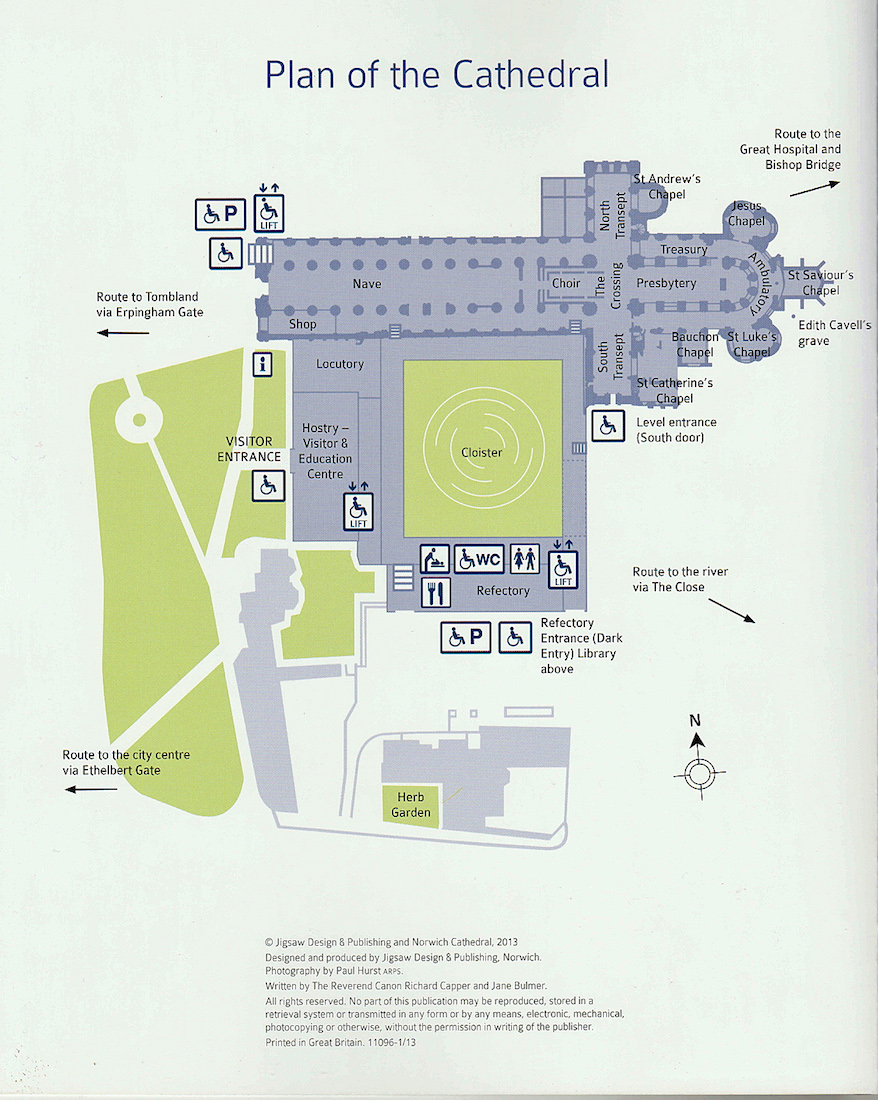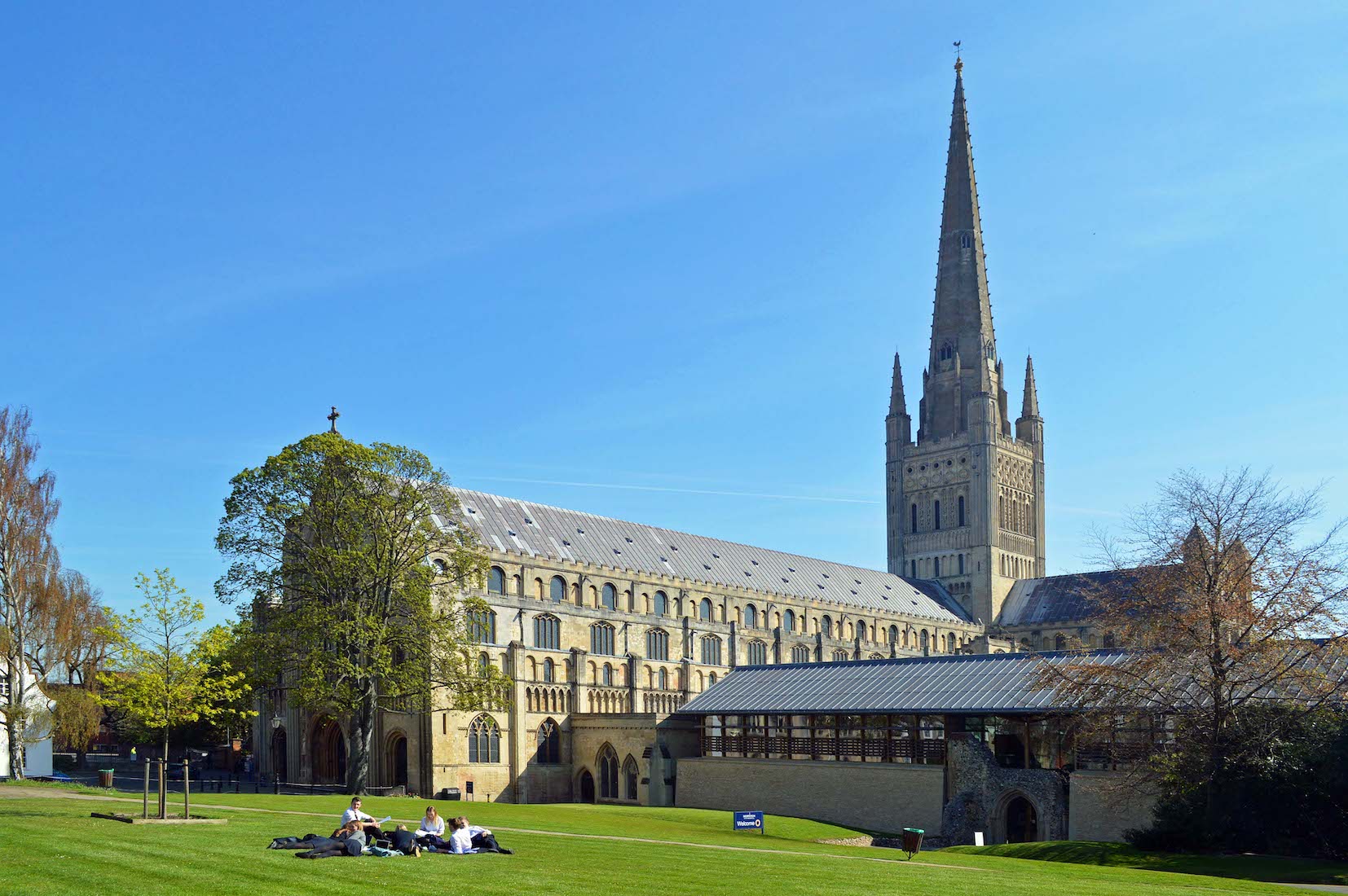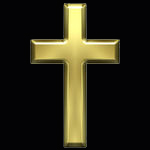NORWICH CATHEDRAL
NORFOLK ENGLAND
PAUL SCOTT

Norwich Cathedral is essentially cruciform in shape, but with a number of chapels towards the Eastern end. The design is a little unusual with the choir extending back into the nave, and the crossing between choir and presbytery. To the South of the nave is a large cloister area, with built-on additions having been made to the West and the South. A large open lawned area to the Southwest provides the best views of the Cathedral.
A history of the Cathedral is given below. However if you wish to begin your tour of the Cathedral immediately, tap / click on START .
You can also access intermediate points in the tour by a tap / click on the following links:
66. North Transept
NOTE ON MAGNIFYING IMAGES
With this website format the images are large enough for most purposes. If there is a need for greater magnification of an image, go to the identical photo on
https://www.flickr.com/photos/paulscottinfo/albums
and use Command - + (Mac) or Windows - + (Windows).
HISTORY
[Wikipedia]
Origins
In 672 the Archbishop of Canterbury, Theodore of Tarsus, divided the Kingdom of East Anglia into two dioceses: one covering Norfolk with its see at Elmham; the other covering Suffolk with its see at Dunwich. During much of the 9th century, because of the Danish incursions, there was no bishop at Elmham; in addition, the see of Dunwich was extinguished and East Anglia became a single diocese once more. Following the Norman Conquest many sees were moved to more secure urban centres, that of Elmham being transferred to Thetford in 1072, and finally to Norwich in 1094. The new cathedral incorporated a monastery of Benedictine monks.
Norman period
The structure of the cathedral is primarily in the Norman style, having been constructed at the behest of Herbert de Losinga who had bought the bishopric for £1,900 before its transfer from Thetford. Building started in 1096 and the cathedral was completed between 1121 and 1145. It was built from flint and mortar and faced with cream-coloured Caen limestone. It still retains the greater part of its original stone structure. An Anglo-Saxon settlement and two churches were demolished to make room for the buildings and a canal cut to allow access for the boats bringing the stone and building materials. These were taken up the River Wensum and unloaded at Pulls Ferry.
The ground plan remains almost entirely as it was in Norman times, except for that of the Easternmost chapel. The cathedral has an unusually long nave of fourteen bays. The transepts are without aisles and the East end terminates in an apse with an ambulatory. From the ambulatory there is access to two chapels of unusual shape, the plan of each being based on two intersecting circles. This allows more correct orientation of the altars than in the more normal kind of radial chapel.
The crossing tower was the last piece of the Norman cathedral to be completed, in around 1140. It is boldly decorated with circles, lozenges and interlaced arcading. The present spire was added in the late 15th century.
Later Medieval period
The cathedral was damaged after riots in 1272, which resulted in the city paying heavy fines levied by Henry III. Rebuilding was completed in 1278 and the cathedral was reconsecrated in the presence of Edward I on Advent Sunday of that year.
A large two-storey cloister, the only such in England, with over 1,000 ceiling bosses was begun in 1297 and finally finished in 1430 after the Black Death had plagued the city.
The Norman spire was blown down in 1362. Its fall caused considerable damage to the East end, as a result of which the clerestory of the choir was rebuilt in the Perpendicular style. In the 15th and early 16th centuries, the cathedral’s flat timber ceilings were replaced with stone vaults: the nave was vaulted under Walter Hart (bishop, 1446–72), the choir under James Goldwell (bishop, 1472–99) and the transepts after 1520. The vaulting was carried out in a spectacular manner with hundreds of ornately carved, painted and gilded bosses. The bosses of the vault number over 1,000; one of the world’s greatest mediaeval treasures, and certainly a near miraculous survival of Tudor and Cromwellian vandalism. Each boss is decorated with a theological image, and as a group they have been justly described as without parallel in the Christian world. The nave vault shows the history of the world from the creation; the cloister includes series showing the life of Christ and the Apocalypse.
In 1463 the spire was struck by lightning, causing a fire to rage through the nave which was so intense it turned some of the cream-coloured Caen limestone a pink colour. In 1480 the bishop, James Goldwell, ordered the building of a new spire which is still in place today. It is of brick faced with stone, supported on brick squinches built into the Norman tower. At 315 feet (96 m) high, the spire is the second tallest in England; only that of Salisbury Cathedral is taller at 404 feet (123 m). The total length of the building is 461 feet (141 m). Along with Salisbury and Ely Cathedrals, Norwich lacks a ring of bells, which makes them the only three English cathedrals without them. One of the best views of the cathedral spire is from St James’s Hill on Mousehold Heath.
17th century
The cathedral was partially in ruins when John Cosin was at Norwich School in the early 17th century and the former bishop was an absentee figure. In 1643 during the Civil War, an angry Puritan mob invaded the cathedral and destroyed all Roman Catholic symbols. The building, abandoned the following year, lay in ruins for two decades. Norwich bishop Joseph Hall provides a graphic description from his book Hard Measure:
- It is tragical to relate the furious sacrilege committed under the authority of Linsey, Tofts the sheriff, and Greenwood: what clattering of glasses, what beating down of walls, what tearing down of monuments, what pulling down of seats, and wresting out of irons and brass from the windows and graves; what defacing of arms, what demolishing of curious stone-work, that had not any representation in the world but of the cost of the founder and skill of the mason; what piping on the destroyed organ-pipes; vestments, both copes and surplices, together with the leaden cross which had been newly sawed down from over the greenyard pulpit, and the singing-books and service-books, were carried to the fire in the public market-place; a lewd wretch walking before the train in his cope trailing in the dirt, with a service-book in his hand, imitating in an impious scorn the tune, and usurping the words of the litany. The ordnance being discharged on the guild-day, the cathedral was filled with musketeers, drinking and tobacconing as freely as if it had turned ale-house.
The mob also fired their muskets. At least one musket ball remains lodged in the stonework. Only at the Restoration in 1660 would the cathedral be restored.
19th and 20th centuries
In about 1830 the south transept was remodelled by Anthony Salvin. In 1930–32 a new Lady Chapel, designed by Charles Nicholson, was built at the East end, on the site of its 13th-century predecessor, which had been demolished during the late 16th century.
Modern works
In 2004 the new refectory (winner, National Wood Awards 2004), by Hopkins Architects and Buro Happold, opened on the site of the original refectory on the South side of the cloisters. Work on the new hostry, also by Hopkins Architects, started in April 2007 after the ‘Cathedral Inspiration for the Future Campaign’ had reached its target of £10 million. It was opened by the Queen and the Duke of Edinburgh on 4 May 2010. The new hostry has become the main entrance to the cathedral. Space has been provided within the hostry for temporary art exhibitions.
The organ was built by local builder Norman and Beard in 1899, but later damaged in a fire in 1938. The current organ is a rebuild of the destroyed organ and is currently the third largest cathedral organ in Britain. A notable addition to the organ was in 1969 when six bells and a rotating star were added to the organ, known as a Cymbelstern. In 2017 the dean, the Very Rev Dr Jane Hedges, revealed that the cathedral was planning to spend around £2 million on rebuilding the organ and supporting its existing choirs.
Helter-skelter
In July 2019, a 55-foot helter-skelter was constructed inside the cathedral, partly for the purpose of attracting more visitors and also giving people a better vantage point for viewing the roof bosses. Reaction to the installation of the slide was mixed, Gavin Ashenden, former chaplain to the Queen, described it as ‘poisoning the medicine’ a church offered. In August 2019, Jonathan Meyrick, the Bishop of Lynn, gave a sermon and sang Words by the Bee Gees from halfway down.
https://en.wikipedia.org/wiki/Norwich_Cathedral#History



